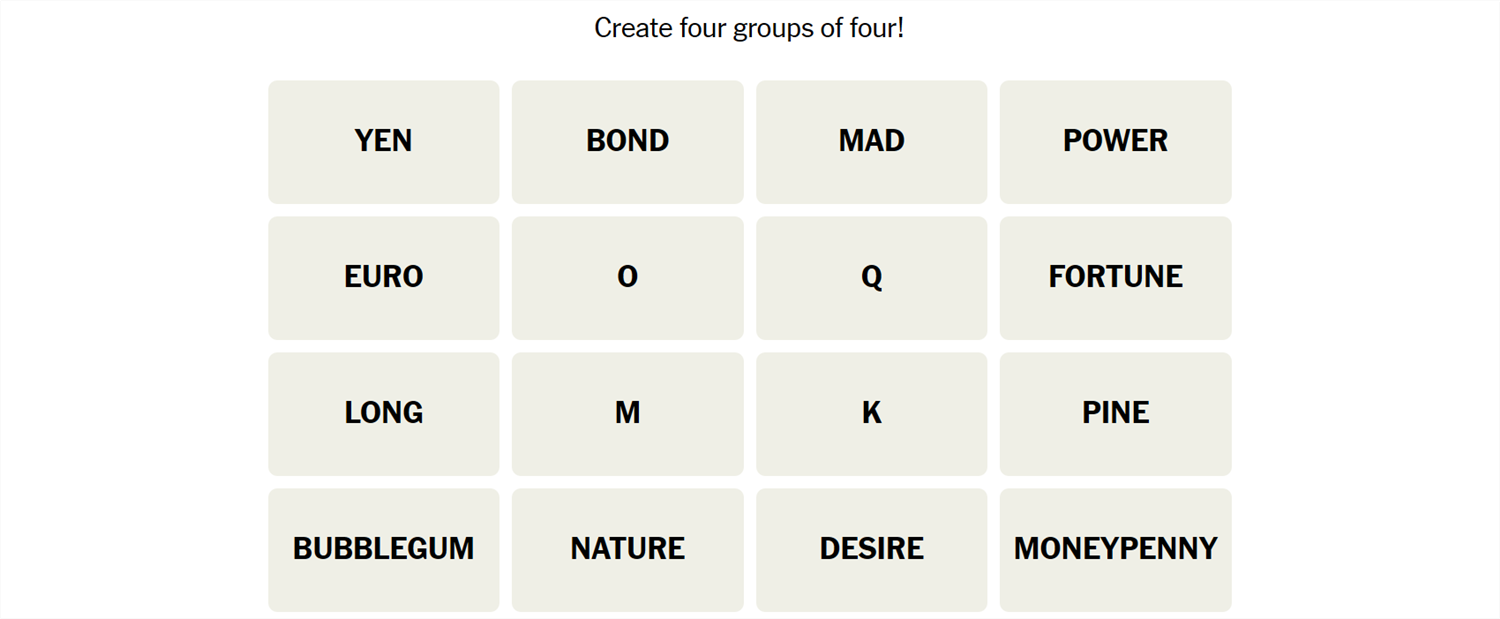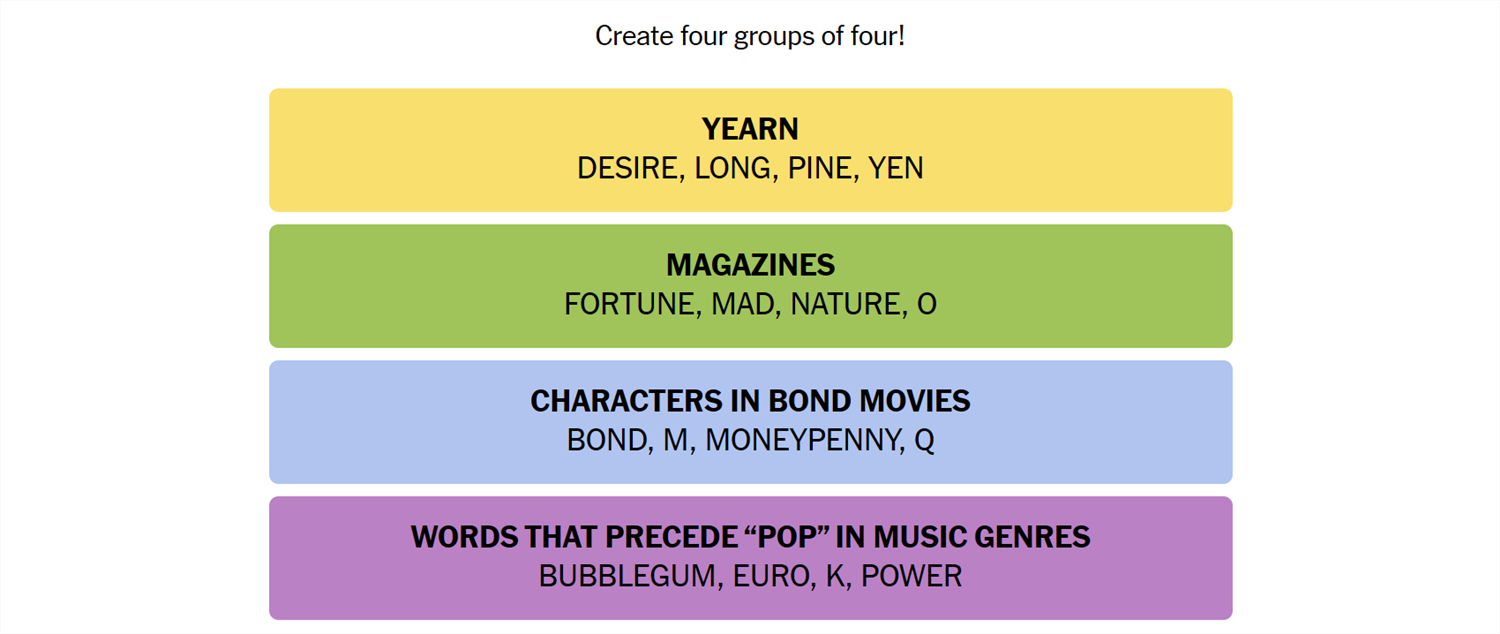
Discover Today's Topical Knowledge: New York Times Discussion Tip & Q&A for July 5 (#390)

Discover Today’s Topical Knowledge: New York Times Discussion Tip & Q&A for July 5 (#390)
Quick Links
- What Is Connections?
- Hints for Today’s Connections Groups
- Today’s NYT Connections Answers
- How Did We Solve This Connections Game?
- How Do You Guess Connections Groups?
Connections is a game from the New York Times that challenges you to find the association between words. It sounds easy, but it isn’t—Connections categories can be almost anything, and they’re usually quite specific. If you need a hand getting the answers, we’ve got you covered.
What Is Connections?
Connections is a game from the New York Times. The objective is simple: sort 16 words into groups of 4. Each group of words will be connected by some common idea or theme. That common element could be anything. We have seen everything from games that rely on the number of letters in the words to categories that require you to spot an extra letter at the end of the word. Sometimes they’re references to economics, other times they reference fairy tales. There is no telling what sort of association there will be between words.
Once you’re confident you understand the connection, select 4 words, then hit “Submit.” You have only four attempts in total, so don’t be too guess-happy.
Hints for Today’s Connections Groups
Here are a few hints for the 390th Connections game to get you started:
- Yellow: When you want something badly.
- Green: Things you might read.
- Blue: People in famous spy action movies.
- Purple: Types of Music.

If you still need help, the actual group names are:
- Yellow: Yearn
- Green: Magazines
- Blue: Characters in Bond Movies
- Purple: Words That Precede “Pop” in Music Genres
Today’s NYT Connections Answers

Yearn (Yellow):
Desire, Long, Pine, Yen
Magazines (Green):
Fortune, Mad, Nature, O
Characters in Bond Movies (Blue):
Bond, M, Moneypenny, Q
Words That Precede “Pop” in Music Genres (Purple):
Bubblegum, Euro, K, Power
How Did We Solve This Connections Game?
July 5th seemed more difficult than July 4th’s game.
The first group I spotted was Yellow, “Yearn. The words were desire, long, pine, and yen. Except for yen, which is a bit more niche, they’re all common synonyms, so nothing too difficult there.
Fortune and Nature are both magazines that stuck out immediately, and skimming a bit more landed me on Mad and O, too. They were in the Green group, “Magazines.”
Bond and Moneypenny pointed me towards James Bond characters, and from there, M and Q were the only real options. Blue was “Characters in Bond Movies.”
That left bubblegum, euro, k, and power—words I could not link together no matter how much I tried. Purple turned out to be “Words That Precede ‘Pop’ in Music Genres.”
How Do You Guess Connections Groups?
There is no quick, reliable way to approach Connections like there is with Wordle, since Connections isn’t algorithmic. However, there are a few things to keep in mind that can help.
- Look for similar parts of speech. Are some words verbs and others nouns? Are some adjectives? Try mentally grouping them based on those categories and see if any other patterns jump out at you.
- Are the words synonyms? Sometimes categories will just be synonyms for a phrase, or very close to synonyms. Don’t rely too closely on this, though. Occasionally, Connections will deliberately throw in words that are sometimes synonyms to mislead you.
- Try saying the words. Sometimes, saying the words helps. One puzzle we saw included the words go, rate, faster, clip, pace, speed, move, commute, and hurry—all of which are obviously related to the idea of motion. However, when you say them, it becomes a little more obvious that only four (go, move, hurry, faster) are things you’d actually say to prompt someone to get moving.
- Expect the red herring . Connections usually has words that could be plausibly, yet incorrectly, grouped together. Take the words Bud, Corona, and Light, as an example. You might instinctively see those three words together and assume they’re lumped together in a category related to beer—but they weren’t.
- Look for distinct words. If a word on your board doesn’t have multiple meanings or can really only be used in one context, try using that word as the basis for a category.
- Shuffle the board. Sometimes, moving words around will help you look at them in new ways.
If you didn’t solve this one, don’t feel too bad—there’s always tomorrow! And those words may align with a topic you’re interested in, giving you a leg up on the competition.
Also read:
- 12 of Our Favorite Free Typing Lessons for All Ages
- AR, VR, MR, XR Demystified: A Comprehensive Guide to Each Technology's Unique Features
- Best Lesbian, Gay Bisexual & Transgender Films to Binge in July 2024 on Netflix
- Best of the Best 10 WebM to MP4 Converters for Easy Conversion
- Can You Unlock Apple iPhone 13 Pro After Forgetting the Passcode?
- Diminish Windows Aural Amplification Feature
- Experience High-End Gadgets on a Budget – Affordable Luxury Tech Picks!
- Fix Windows 1N's Broken Search Function with Easy Solutions
- In 2024, Subtle Sound Shifts in Garageband Productions
- Mastering Performance: Fixing Stutters and Crashes in Assassin's Creed Odyssey on Windows - 2024 Edition
- Quick Solutions for Getting Netflix Back Up on Your LG TV – 19 Tips Inside
- Revolutionize Your Company's Funding Through Blockchain Tech - Insights by YL Computing & YL Software Experts
- Step-by-Step Tutorial for Forcibly Closing Apps on a Windows 11 Laptop or Desktop
- The Blue Enigma What's Behind the Symbol on Facebook Messenger?
- Top 13 Complimentary Hard Disk Diagnostic Utilities - July 2024 Edition
- Title: Discover Today's Topical Knowledge: New York Times Discussion Tip & Q&A for July 5 (#390)
- Author: Robert
- Created at : 2025-01-22 18:42:20
- Updated at : 2025-01-25 20:19:17
- Link: https://techtrends.techidaily.com/discover-todays-topical-knowledge-new-york-times-discussion-tip-and-qanda-for-july-5-390/
- License: This work is licensed under CC BY-NC-SA 4.0.